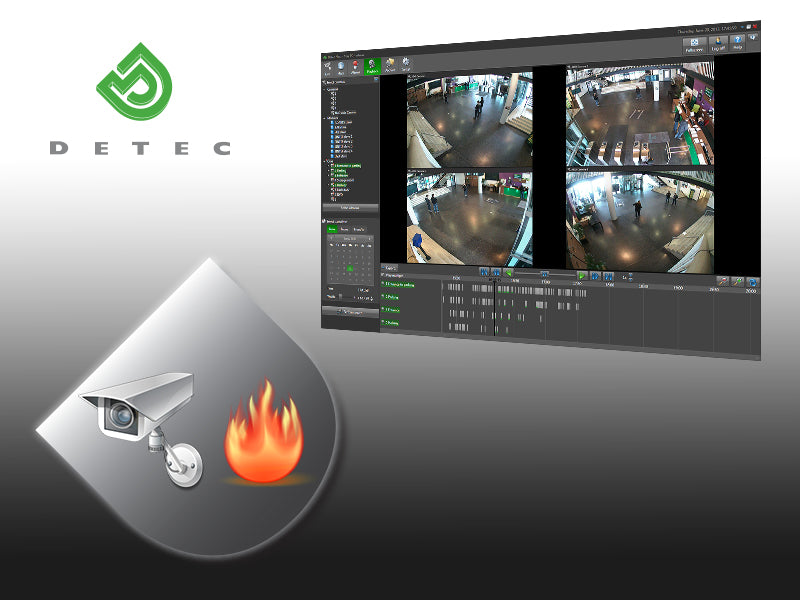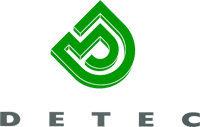Detec
Detec Next RAD Camera License
Detec Next RAD Camera License
Couldn't load pickup availability
Detec Next RAD is the term of a camera license where you use radiometric thermal cameras from FLIR for temperature measurement to connect to a Detec Next system.
With Detec Next RAD, an alarm is generated when one or several pixels in the image become warmer than a certain trigging temperature.
The trigging temperature is calculated continuously and adapts to the surroundings in the image. The trigging temperature will rise if the average temperature in the image rises and when the temperature differences in the image grow. Equally, the trigging temperature will sink if the average temperature in the image is low and when the temperature differences in the image drop. This makes the software able to respond as quickly as possible on critical temperatures or potential fires throughout the year.
The trigging temperature will maintain within certain configurable limits, meaning that the trigging temperature will never go lower or higher than predefined values.
Description
Detec Next RAD get temperature data from a radiometric thermal camera (selected models only) several times per second. This data contain the temperature for every pixel in the image. Detec Next RAD utilizes the advanced detection module from Detec Next PRO to analyze the temperature data.
It is possible to decide that temperature data, such as minimum, maximum and trigging temperature, shall be stamped visually in the image that goes to storage and display. Then you can retrieve video recordings and see what the temperatures in the image have been.
It is also possible to log temperature data. The logged data will show minimum and maximum temperature, standard deviation, trigging temperature etc. image by image. The data can be further processed in e.g. Microsoft Excel.
Using Radiometric Thermal Cameras for Temperature Measurement
The temperature data is processed for two different video streams:
One of the video streams will become a grey-scale video stream that shows the difference between temperatures in the image, and where the pixels that are above the temperature limit value of an alarm (trigging temperature) are colored in magenta. The image is sent for storage and live display, and lets the user easily identify how the scene looks like visually, and where in the scene the alarm has been detected.
The other video stream is only used by the video analysis module. It is a video stream where the pixels below the trigging temperature are black, while pixels above the trigging temperature are white. This is done in order for the analysis module to only discover temperatures over the set limit value (white pixels), and to ignore all black pixels below the set limit value. As this method gives a maximum of contrast, the detection module can easily register that only one pixel in the image has surpassed the trigging temperature.
False alarms caused by reflections from the sun are tried to be removed from the image being detected. Pixels in the image where the temperature rise faster than a set limit during a certain time scale and is considered to be sun reflection, and will not notify an alarm. In addition, if you experience problems with moving heat sources, e.g. snowploughs scraping against the asphalt, you can add detection rules to filter out these kind of events (as a fire does not typically move around in the scene).
If you get an alarm the system should consider real, but the operator wants to ignore it for a given time, the operator can simply mark the area directly in the camera image, and set how long the alarm shall be ignored. Examples of such events are residents using their grill, or a roofer operating a welding machine.
Using Radiometric Thermal Camera for Video Analysis
Detec Next can also use the same cameras used for temperature measurement for video analysis too.
That will require an extra Detec Next PRO camera license in addition to the Detec Next RAD camera for this camera.
As mentioned previously, the Detec Next PRO software collect temperature data from the camera multiple times per second and generate an image based on these temperature data. These images are then sent for video analysis, such as for regular thermal, IP-based or analog cameras. For details on video motion detection, please refer to separate data sheet on the Detec Next PRO camera license.
The Detec Next PRO analysis automatically adapts the contrast in the image based on data on minimum and maximum temperature from the radiometric thermal camera, making it as vivid as possible to see temperature differences in the image. The coldest areas in the image become black, the warmest become white, and those in between get a gray-scale nuance depending on the temperatures they radiate. This leads to a clear carving of objects in the scene, and regular detection criteria can be used.
The contrast takes some time to adjust to changes in the temperature data. This is done deliberately to avoid a really cold or warm object entering the camera scene to rapidly change the entire image, causing a false alarm.
It is also possible to specify upper and lower limits for the temperatures that are displayed, preventing e.g. that an object that is much higher in temperature than the rest of the image, will make the contrast for the rest of the image suffer.
Please contact us for a list on supported radiometric thermal cameras and recommendations for hardware based on your needs.
Downloads
Share

Featured collection
-
Milesight MS-C4472-RFIPE-3610 (NDAA) 4MP, 4K, Super WDR, IR50, Minidome, AI, IP Camera, 3.6mm-10mm
Regular price $0.00 USDRegular priceUnit price / per -
Milesight MS-C8172-FIPA (NDAA) 4MP, 4K, Super WDR, IR50, Minidome, AI, IP Camera, 2.7 - 13.5mm
Regular price $0.00 USDRegular priceUnit price / per -
Milesight MS-C8175-FPD (NDAA) 8MP,4K, Super WDR, IR50, Minidome, AI, IP Camera, 2.7 - 13.5mm
Regular price $0.00 USDRegular priceUnit price / per -
Milesight MS-C2972-RFIPE-27135 (NDAA) 2MP, WDR, IR50, Minidome, AI, IP Camera, 2.7 - 13.5mm
Regular price $0.00 USDRegular priceUnit price / per





